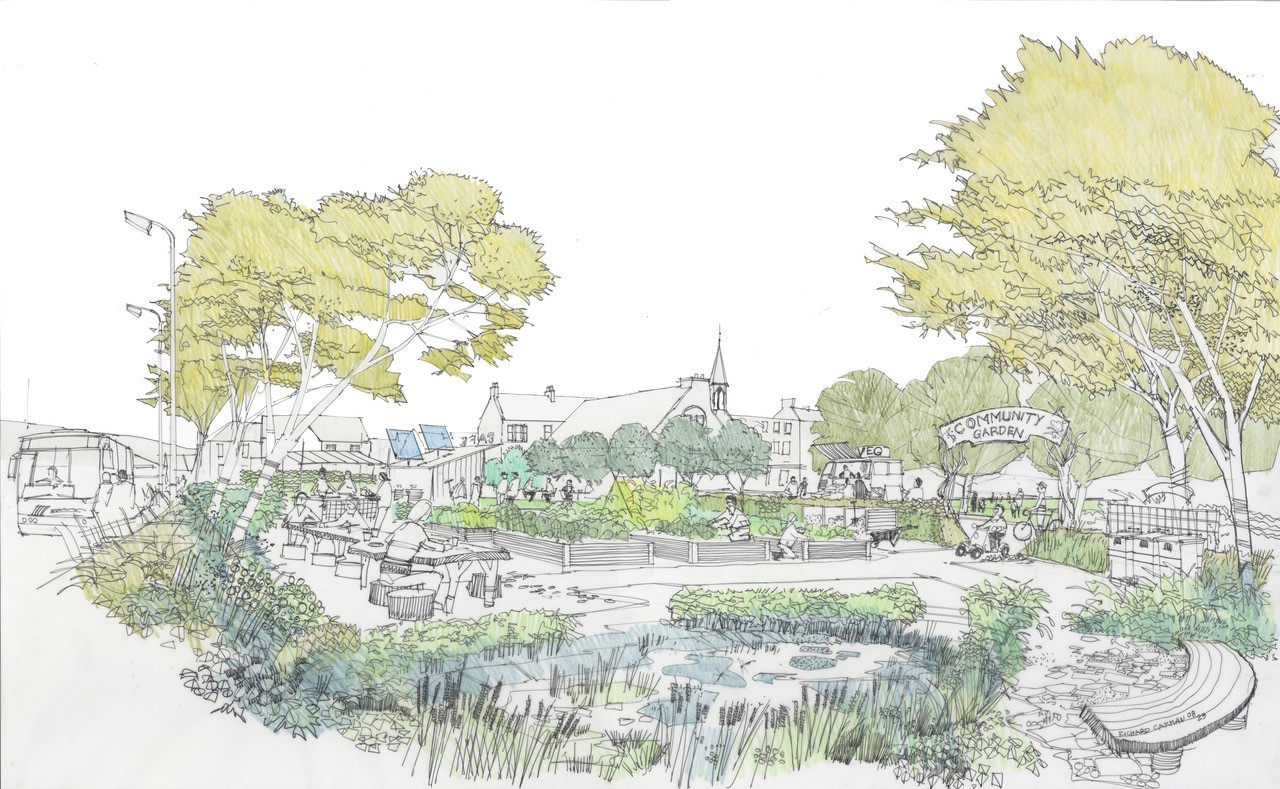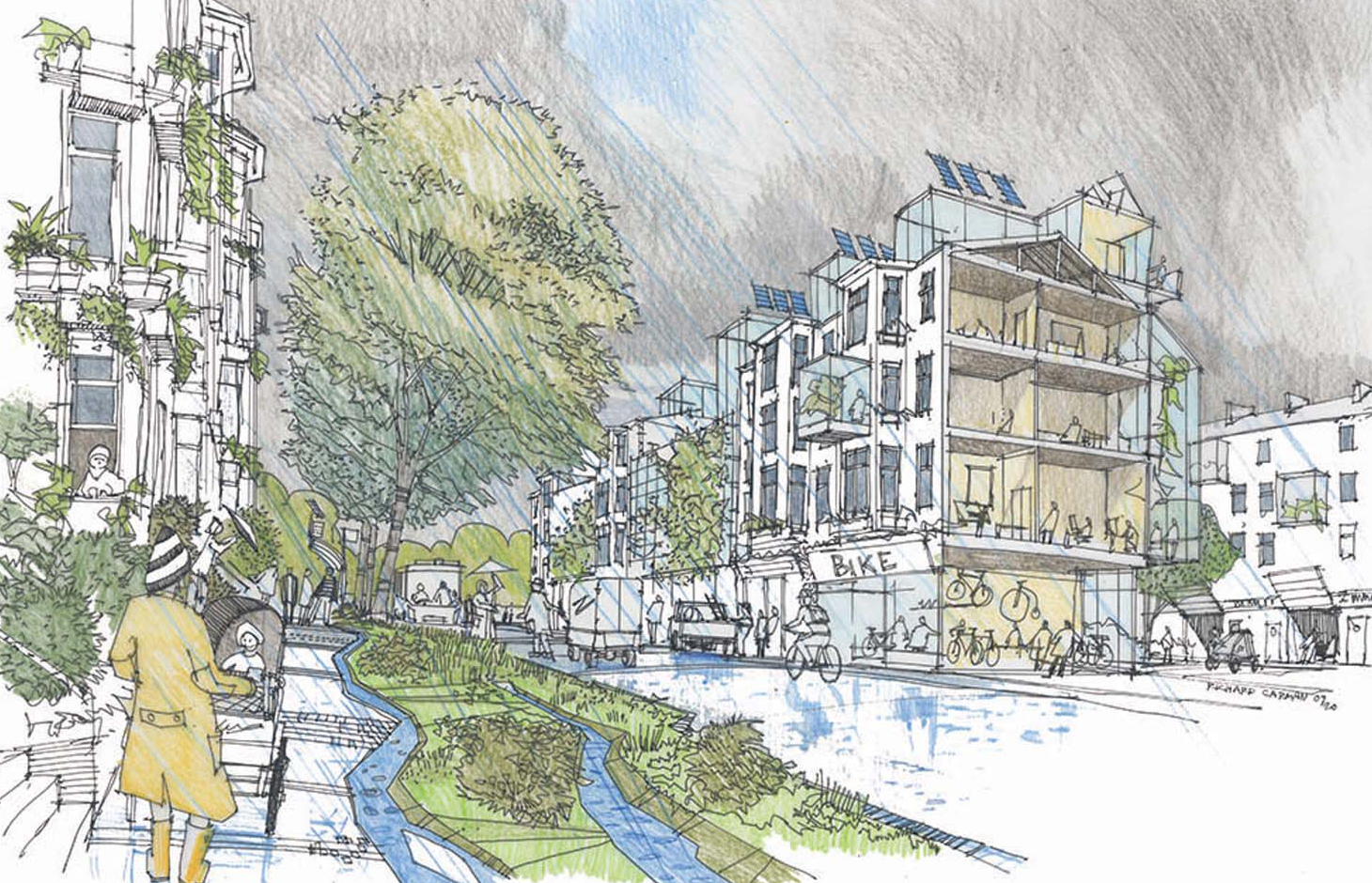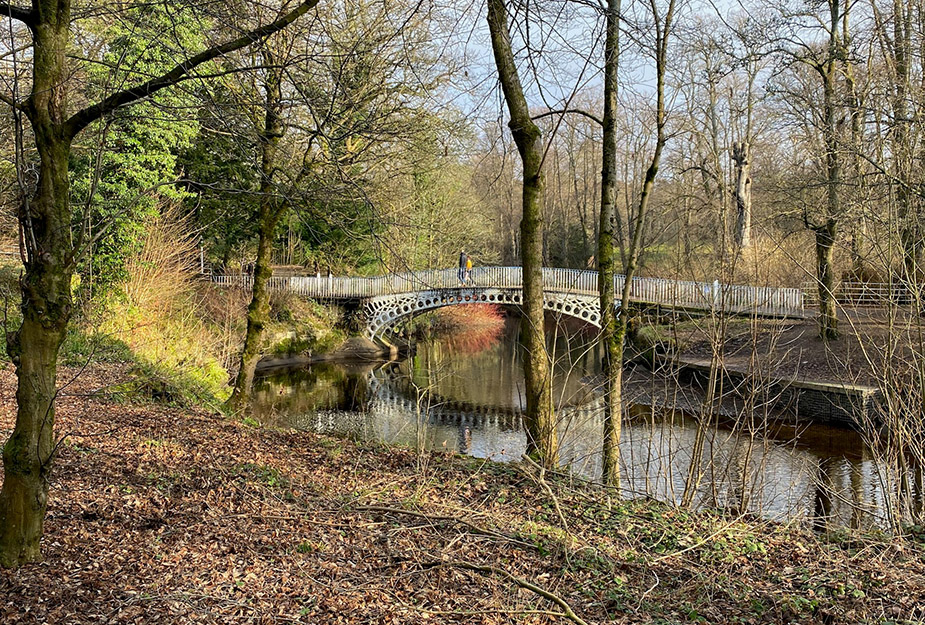At Architecture and Design Scotland, we are passionate about helping communities create sustainable, liveable and productive places. One key approach we are exploring is blue-green infrastructure, a nature-based solution that harnesses the power of water and our green environment to rethink how we can manage surface water due to increased heavy rainfall and flood risk for town, city and regional planning.
What is a blue-green infrastructure?
Blue-green infrastructure refers to a network of water and green areas to create an ecosystem that uses nature’s potential to provide multiple ecological, social and economic benefits.
By employing a combination of open spaces, green areas, water bodies, and engineered solutions, blue-green infrastructure seeks to create a sustainable and resilient environment that improves habitats for wildlife and ensure our communities thrive.
Does Scottish Government’s current policy encourage blue-green infrastructure delivery?
In February 2023, the Scottish Ministers adopted the National Planning Framework 4 (NPF4). The latest planning framework includes a variety of spatial principles such as local living and compact urban growth that aims to support the planning and delivery of sustainable, liveable and productive places.
Blue and green infrastructure is also prioritised as a National Planning Policy whereby Local Development Plans ‘should identify and protect blue and green infrastructure assets and networks; enhance and expand existing provision including new blue and or green infrastructure.’
A blue-green infrastructure is no longer a desirable, but a requirement for all local authority areas in Scotland to consider in planning their future places.

Advantages of blue-green infrastructure
Blue-green infrastructure can bring a variety of advantages to town, city and regional planning. From flood mitigation to recreational community spaces the scope of benefits makes it a promising solution that can benefit our people and places.
Flood mitigation
In areas prone to heavy rainfall and flooding, blue-green infrastructure offers a natural defence against these events. Instead of relying solely on traditional concrete structures like flood walls, it employs techniques like rain gardens, green roofs, and permeable pavements to slow, absorb and manage excess water.
Biodiversity enhancement
Blue-green infrastructure supports diverse habitats, enabling flora and fauna to thrive within urban settings. By incorporating natural elements such as wetlands, green corridors, and wildlife-friendly areas, it helps maintain healthy ecosystems and preserve biodiversity.
Air quality improvement
Vegetation in blue-green infrastructure areas plays a vital role in purifying the air by absorbing pollutants and releasing oxygen. This helps combat air pollution, leading to improved public health and quality of life.
Heat island reduction
Urban areas often experience the "heat island" effect, where temperatures rise due to heat-retaining surfaces. Blue-green infrastructure utilizes green spaces to cool down urban environments, mitigating the impacts of extreme heat and fostering a more comfortable atmosphere for residents.
Health and wellbeing improvements
Blue-green infrastructure creates attractive public spaces that promote physical activity, relaxation, and community interaction. Parks, greenways, and accessible waterways encourage citizens to embrace and enjoy the outdoors, and promote positive social interactions.
Barriers of delivering blue-green infrastructure
Despite the advantages mentioned, delivering a blue and green infrastructure can come with its own sets of challenges.
Spatial limitations
Finding suitable land, especially in urban places can be challenging. Competing demands for land use and existing infrastructure constraints need to be considered prior to selecting an area for application.
Knowledge and awareness
Not all professionals and stakeholders have the necessary knowledge or design skills to implement a blue-green infrastructure. Getting the right people, such as Landscape Architects, involved from the outset of the project will help to ensure the right type of solution is selected for your agreed area.
Maintenance and responsibility
Different organisations and agencies are often responsible for managing different aspects of water, landscape, land and development. Keeping the different elements maintained requires collaboration and may need new or different skills or approaches.
Public awareness
Gaining community awareness and buy-in for a blue-green infrastructure project requires clear communication and public engagement to address any potential concerns that may arise during the planning and delivery stages. Engaging your community in the design process can also help to shape your projects direction.

Why we should consider a blue-green infrastructure
It is important to note that adopting a place-based collaborative approach to planning and designing for a blue-green infrastructure project can help to resolve the barriers mentioned above.
Blue-green infrastructure represents a progressive approach to town, city and regional planning, acknowledging the significance of nature's contribution to sustainable development.
By harnessing the resilience of natural ecosystems, Scotland can demonstrate its commitment to creating places that can withstand the challenges posed by the climate emergency and rapid urbanization.
As other regions around the world seek innovative solutions to their urban challenges, blue-green infrastructure stands as a catalyst, inspiring us to embrace nature-based solutions for a greener, more resilient future.
Examples of our work
We will continue to update this article with new projects related to our work. Below includes one of the projects we have been a part of to date that explore the use of this concept in a town setting.
In 2021, our Key Agencies Group Green Recovery offer with East Ayrshire Council saw us facilitating a workshop, bringing a place-based collaborative approach to managing flood risk in Kilmarnock’s town centre, industrial areas and derelict sites.
Agency colleagues noted that: “We saw an identifiable change in mindset where the council started to see water as an asset, rather than just flooding as the issue.”
The presentations and focus groups we curated helped to open up the conversation, to show the ‘art of the possible’ and to translate that learning into achievable actions and leadership by the council.
During the workshop, panellists shared good practice in developing blue-green infrastructure strategies at four key scales:
- national policy context
- strategic scale
- townscape scale
- site-specific scale
These presentations, including three by our Design Advice panellists played a key part in showing what is possible with the added benefit of creating a series of training videos.
Our work with Kilmarnock is still ongoing. Using the project as a case study, the lessons learned here will be applied further to other flood resilience strategies across Scotland.
Examples of other blue-green infrastructure projects in Scotland
Scotland has been adopting and embracing blue-green infrastructure to help support designing for climate change and delivering social benefits. Several notable projects exemplify the trial and implementation of blue-green infrastructure principles across the country.
Glasgow, Scotland’s largest city is having to rethink how it deals with surface water due to increased heavy rainfall and flood risk. Rather than putting water underground blue-green infrastructure can deliver many wider benefits.
The 10,000 Rain Gardens: Glasgow Pilot aims to work with local communities at Queensland Court and Gardens and ‘establish raingardens as a standard method of dealing with surface water management, flood alleviation and greenspace creation within Scotland.’
The Claypits Local Nature Reserve is an inspiring example of sustainable design, climate adaptation, nature restoration and all through close collaboration with local communities and various project partners. What was once derelict land has blossomed into a haven for both nature and residents.
It transforms a derelict 10ha site into a vibrant Local Nature Reserve (LNR) with diverse features like boardwalks, mountain bike trails, and accessible fishing pegs. It also serves as a surface water drainage solution for surrounding areas, dynamically managing canal water levels to prevent flooding.
This project represents a community-driven effort, born from the desire to create a "wild park" in north Glasgow. Community involvement extended beyond initial vision; charrettes fostered collaboration and shaped the project's direction.
The Greater Easterhouse project has helped create new and improve open space through an integrated green and blue network in two areas, Cranhill/Ruchazie and Blairtummock, to create connections to 7 Lochs Wetland area.
The project has supported the renewal of 29ha of land in an economically and socially deprived area of Scotland into a mix habitat of networks including wildflowers, wetland, woodland and grassland.
Local communities helped develop the green infrastructure designs through a series of workshops.
Header image Penny Farthing Bridge, Glasgow by Steve Malloy on Unsplash

